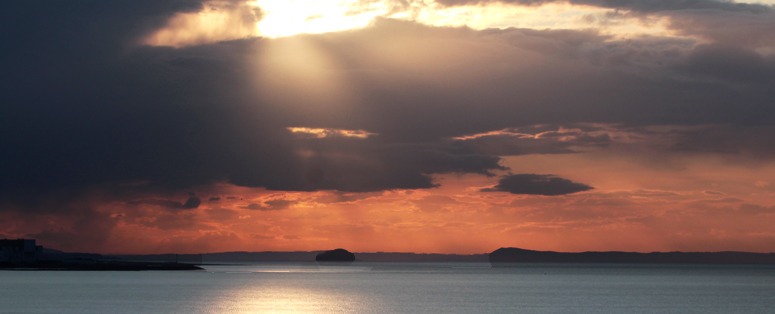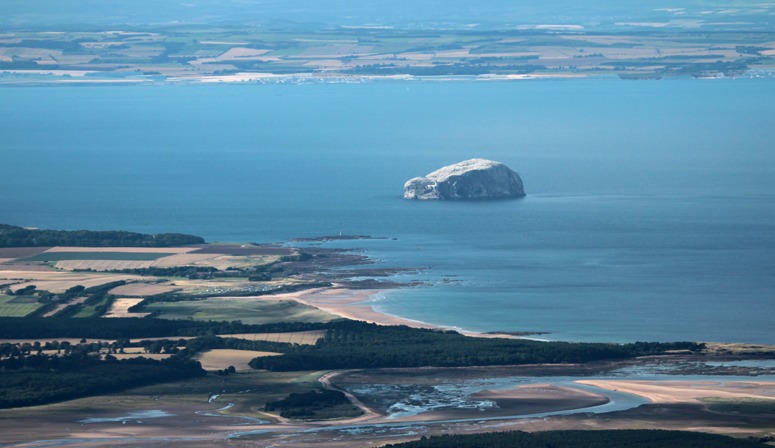James Hutton lived 15 km south of the Bass Rock and used the geology of the region to support his Theory of the Earth, which argued that the Earth had evolved slowly, rather than being created in a week (as described in the Bible).
Gilbert Laing Meason invented the term ‘landscape architecture’, in 1828. Meason lived near Forfar (60 km north of the Bass Rock) which might be visible on the above photograph if it had been taken on a clearer day
John Claudius Loudon was the most prolific writer on gardens and architecture of his age. He designed some of the first public parks, proposed a system of Breathing Zones for London and transmitted the term ‘landscape architecture’ to Downing and Olmsted . Loudon spent his childhood at Gogar 40 km west of the Bass Rock
John Muir is regarded as the Father of America’s National Parks. John Muir was born in Dunbar (15 km from the Bass Rock) and the estuary in the foreground of the above photograph is now the John Muir Country Park.
Patrick Geddes, the first European to use ‘landscape architect’ as a professional title was the most innovative town and country planner of the twentieth century. Patrick Geddes was born near Perth (25 km north of the Bass Rock) and lived in Dundee and Edinburgh
Ian McHarg wrote the most influential landscape architecture book of the twentieth century (Design with nature) and contributed to the development of Geographical Information Systems (GIS) McHarg was born in Clydebank, 80 km west of the Bass Rock and near the boundary between the tectonic plates which were joined to make Britain
George Eliot wrote, in Adam Bede, that ‘a gardener is Scotch, as a French teacher is Parisian‘. She lived 1819–1880 and would have been on even stronger ground if writing about landscape architecture and planning!

The Bass Rock (centre of photo) is one of many extinct volcanoes which form the landscape architecture of Scotland's Central Belt
See map history of How Britain was Formed. When the sun is setting (above) one gets a glimpse of how the region looked when the boundary between the Gondwana and Euramerica plates was full of volcanic activity, as Iceland is today, but the Devonian climate was hotter and drier.


An impressive list of LAs born in the region. Is there anything in their work to suggest the homeland influence?
Fantastic! Photographs! I even can not make any comments because of them! I’m just wondering How wonderful it is to jump into the river! Romantic!
Thank you for this blog. For me, it is very interesting and wrriten in a very personal and unique perspective. The Bass Rock is mysterious and is like a “witness” of the geography change and the birth of so many landscape pioneers, who are very different from the “normal landscape architects,teachers and planners. They like form thier own idea which is just like the unparalleled topography in Scotland itself. Nature is the most powerful educator!
However, from the theorist-list, it is a shame that there is not a contemporary Scotish landscape theorist who has influenced this profession. Is that you forgot to write it or you can not find it?
I suppose ‘coincidence’ is the most likely explanation for the Scots landscape theorists – but I prefer the idea that the landscape influenced the people and I think geography is under-estimated as an influence on individuals and nations. For example, if the populations of Europe and China had been switched 2000 years ago would the geography of Europe have given the Chinese a ‘European’ character and the Europeans a ‘Chinese’ character?
I do not know enought about Scotland’s landscape architecture profession today and it needs to be remembered that (1) there are more people of Scots descent outside Scotland than inside Scotland (2) ‘no man is a prophet in his own country’.
I have another idea: let us claim Charles Jencks as Scottish landscape theorist. His mother (a Macduff) was born in Fife (on the far shore in the above photograph) and he lives at Portrack House in Scotland AND he is the most significant theorist to have given his attention to landscape architecture in recent times. As a young man Jencks focussed on architecture. In his maturity, and as a designer, he is focussing on landscape architecture.
Shakespeare made the name Macduff famous, in Macbeth, and linked it to the ancient forest of Birnham, at Dunkeld :
Though Birnam wood be come to Dunsinane,
And thou opposed, being of no woman born,
Yet I will try the last. Before my body
I throw my warlike shield. Lay on, Macduff,
And damn’d be him that first cries, ‘Hold, enough!’
Macduff suspects Macbeth of regicide and kills him in the final act of the play.
Charles Jencks is one of my favorite landscape designers although he started as a architect. I always found his work which has rhythm adapt to the environment and surrounding.
Jencks studied English literature and then architecture. His conversion to landscape architecture came about in Scotland and through the garden (Portrack House) he made with Maggie Keswick, his wife and the author of a book on Chinese gardens. Just perhaps, one could find a Chinese influence on his work: an interest in representing the nature of the heavens in garden and landscape design (though one could also find this interest in the history of European art).
I may not know the characteristic his design, but I always have a opinion to judge the quality of design. When the work can speak itself, then it is a good work. I also think the most significant “job” of a art work and a landscape work is ” delivery emotion.
It is great to see a design which delivers an emotional ‘charge’ but it is not so easy to set this as an objective for the design process.
No, it is easy! Tom, you are “out”.(!)
Perhaps the following description of expression in art may help?
“There are expressionistic features within many different art styles and movements. Artists make choices about color, line, texture, and composition to evoke or express feelings. Sometimes this leads to abstracting a subject to make it more expressive.”
Some designers do deliberately set out to ‘shock’ their audiences. However, the value of ‘shock’ is short-lived. [ http://en.wikipedia.org/wiki/Shock_value ] So perhaps if you were to set an exercise that demonstrated the ability of design to evoke an emotional response this would be the emotion most easily exploited.
I always find myself going back to Vitruvius when thinking about the the design process. I don’t think he mentions emotion but he is strong on the subject of responding to the nature of place, which is partly the geography of the place.
Yes. In the instance of Vitruvius delight is the emotional response (and perhaps the optimal one).
Vitruvius’ word was Venustas and the translation ‘Delight’ is unsatisfactory. Venustas was the quality possessed by the goddess Venus and needs to be interpreted in the context of both Greek and Roman religion and philosophy. I am sure this included emotion but not sure that emotion was of its essence. But nor do I know enough about the subjects to write with confidence about them.
I have read Loudon’s magazine, a bit from his books, and then a bio on him. He is a hero to me. perseverance when your body hurts, determination to carry out his goals, love of plants, eager for a good design, seeker of the public good, talent in writing. I can see why he was called ‘the father of the English garden’.
Here in the US Scotsman Robert Buist became one of the most important seedsmen in the nineteenth century. His business offered seeds and plants for generations here in the US. He also wrote garden books.
When I first saw Loudon’s drawings (probably from the Suburban Gardener) I took a dislike to him. Since then I have read many of his books – and the more I read the better I like him, for all the reasons you give.